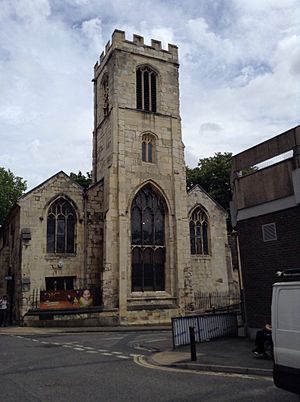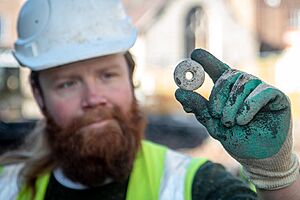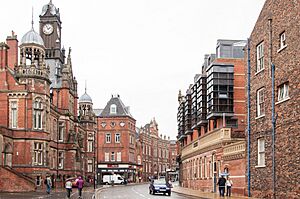DIG: An Archaeological Adventure facts for kids

DIG is located in the historic St Saviour's Church in York
|
|
| Established | 2006 |
|---|---|
| Location | St Saviourgate, York, England |
| Type | Interactive archaeology centre |
| Founder | York Archaeological Trust |
DIG: An Archaeological Adventure is a super cool place in York, England. It's where you can learn all about archaeology! This fun center is run by York Archaeology. It's located inside an old church called St Saviour's Church. This church was built way back in the 1400s. In the 1990s, it was turned into a place for learning about history.
At DIG, you get to be a real archaeologist for a day. You can dig for treasures and study old objects. You'll explore four different time periods: Roman, Viking, medieval, and Victorian. You'll use special digging tools to find both fake and real artifacts. There are also cool screens and displays that teach you about how archaeologists work. They also explain what life was like in the past.
The area around DIG in York is very special. It has many layers of history buried underground. The ground is often wet, which helps to keep old things safe. This makes York a great place for finding ancient objects. Archaeologists have found many amazing things here over the years. These discoveries help us learn about the past.
DIG is a place for everyone. It has special features to help visitors with different needs. It's a great spot for families and school trips. You can even get an annual pass to visit many times! DIG is part of a group of places run by York Archaeology. This group also includes the JORVIK Viking Centre and Barley Hall.
Contents
The Story of DIG's Home: St Saviour's Church
DIG is located in a very old building called St Saviour's Church. This church is a Grade II listed building. This means it's a very important historical building. It's a great example of old architecture.
Records show that a church has been on this spot since the 1000s. The church you see today was mostly built in the 1400s. It has a Gothic style with big pointed windows. It also has beautiful carved stone and wooden roofs. For hundreds of years, St Saviour's Church was a local church. It served the people living in the center of York.
In the mid-1800s, over 2,800 people lived in the church's area. This included many children and people with different jobs. There were shoemakers, innkeepers, and even teachers. The church was in a busy part of the city. It connected shopping areas with homes. In the 1800s, the area had pubs, schools, and many workplaces. The church was a key part of local life. It served both rich and working-class families.
By the mid-1900s, fewer people went to church. So, like many city churches, St Saviour's Church was no longer used for religious services. The York Archaeological Trust bought the church in the 1970s. This group is a charity that studies and teaches about archaeology.
At first, the church was used to store archaeological finds. Then, in the early 1990s, the Trust turned it into the Archaeological Resource Centre (ARC). This was a new kind of learning center. It focused on hands-on archaeology. The ARC let visitors try out real archaeological work. They could dig, study objects, and learn about history. The building kept its old church features. But it also added new spaces for learning. These included fake digging areas and interactive displays.
The Archaeological Resource Centre (ARC) closed in July 2005. It then reopened in March 2006 as DIG: An Archaeological Adventure.
DIG and the York Archaeological Trust
The York Archaeological Trust (YAT) is one of the biggest archaeology groups in the UK. It started in 1972. This was to protect old sites that might be damaged by new roads. YAT runs DIG: An Archaeological Adventure. They have also done a lot of important archaeological digs in York.
YAT's most famous discovery was in the Coppergate area. Between 1976 and 1981, they found amazing Viking buildings. They also found over 40,000 Viking objects! These discoveries led to the creation of the Jorvik Viking Centre. This center shows what Viking life was like.
DIG and the Jorvik Centre are important parts of YAT's work. They help people learn about archaeology. They also encourage everyone to get involved.
Besides DIG and Jorvik, YAT runs other cool places. These include Barley Hall, a restored medieval house. They also manage Micklegate Bar, an old city gate with an exhibition. YAT also puts on the JORVIK Viking Festival every year. This is one of Europe's biggest Viking festivals. All these places work together to teach people about history.
YAT also works with universities and government groups. They do important research on ancient environments. For example, they have studied soil from Roman sewers. YAT has also explored 1800s working-class homes. These were found in an area called Hungate. Today, YAT works all over the UK. They have offices in cities like Glasgow and Nottingham.
What You Do at DIG: A Visitor's Journey
Your adventure at DIG starts in a special digging area. There are four fake digging pits. Each pit shows a different time in York's past. You can dig in Roman, Viking, Medieval, or Victorian layers. The digging area uses colored rubber bits. These look like the different layers of soil archaeologists find. You get to use small trowels and brushes. You'll dig up real and fake artifacts. These might include Roman plaster or Viking tools. You could also find medieval burial items or Victorian household objects.
After digging, you move into different themed rooms. These rooms show how archaeologists study their finds. You'll learn how they figure out what objects are. You'll also learn how old they are and where they came from. Activities happen in places like a "Field Tent" and a "Research Library." You can do hands-on projects. You'll use computers and see cool holographic images of archaeologists. There are also big picture panels to explain things.
You can even touch real artifacts in the interactive lab. You can use the exhibits yourself. You might even meet "archaeologist" characters! You can also use computer databases to learn more. The last part of the exhibition is called "York Revealed." This uses 3D technology to rebuild old York. It shows what the city looked like based on what was found at DIG. Holographic archaeologists appear in different areas. They tell you about the objects found there. Moving platforms show models of old buildings. You can also see virtual Romans, Vikings, and Victorians. They show what life was like back then.
Upstairs, there's a space for kids' education. They also hold special workshops there. There's also a room for teachers and researchers.
DIG is designed to be fun for everyone. It works well with the JORVIK Centre. Together, they show you the whole journey. You learn from finding old things to rebuilding history.
How York's History is Preserved Underground
York is a city with over 2,000 years of people living there. This means it has many layers of history buried deep underground. DIG: An Archaeological Adventure is right in the middle of this historical area. Since the 1970s, York Archaeological Trust has done many digs here. They have found layers of human activity. These layers go all the way from Roman times to the medieval period.
Archaeological sites in York are very deep. Some are up to ten meters deep! This is especially true near the Rivers Foss and Ouse. The ground here is often wet and has no oxygen. These conditions are perfect for keeping old organic materials safe. Things like medieval wood, leather, seeds, and even insect remains are found. These finds help us understand ancient environments and climates.
These layers built up over time. This was not just from nature. It was mostly from people living there. People threw away trash and built new things. Roads were built, and industries created waste. All this slowly raised the ground level. This also changed the water level underground. It helped to seal and protect the old layers. This is why archaeologists can find so much here.
Archaeologists in York also use tiny details to study the past. They look at pollen, insects, and soil. They also examine artifacts very closely. These methods help them learn about local weather and plants. They can also see how people affected the environment. For example, they found types of beetles in early medieval layers. These beetles don't live in York today. This tells us that the climate was different back then.
Changes in York's rivers also show environmental changes. Roman layers don't have much flood dirt. But later medieval layers often have silty deposits. This shows that there were many floods in the 1200s and 1300s. These floods were not just from climate changes. They were also caused by farming, cutting down trees, and bad drainage systems.
These buried layers in York are very important for archaeology. They are also key to the city's public history projects. DIG uses real findings from York's unique history. Even though it's a simulated dig, it shows you what real archaeology is like.
How DIG Operates
DIG is run by York Archaeology. This is a charity focused on education. The money from ticket sales helps support their work. This includes school programs and archaeological research. It also helps protect historical sites. And it helps run other visitor attractions. So, when you visit DIG, your money helps teach more people about history.



